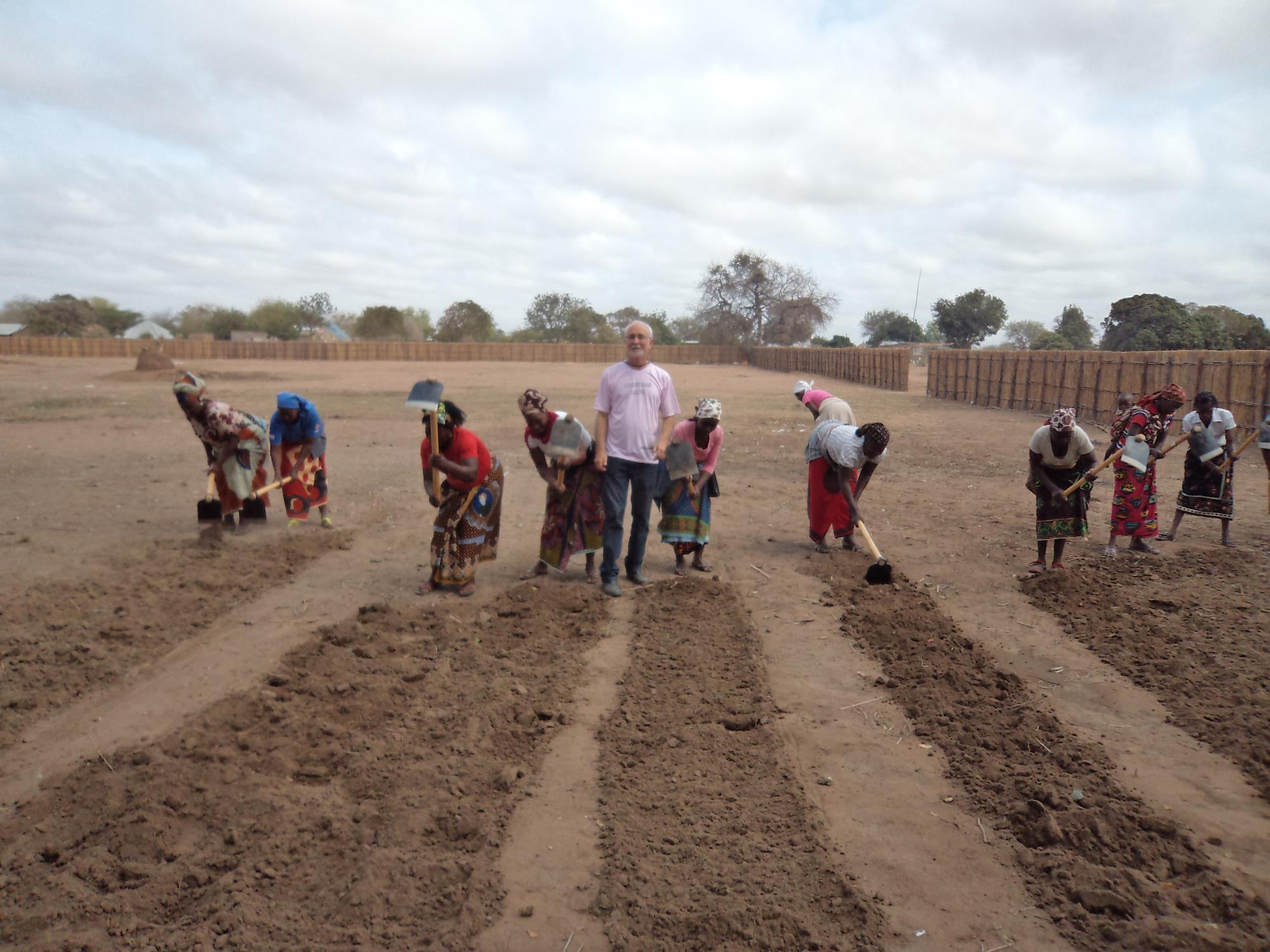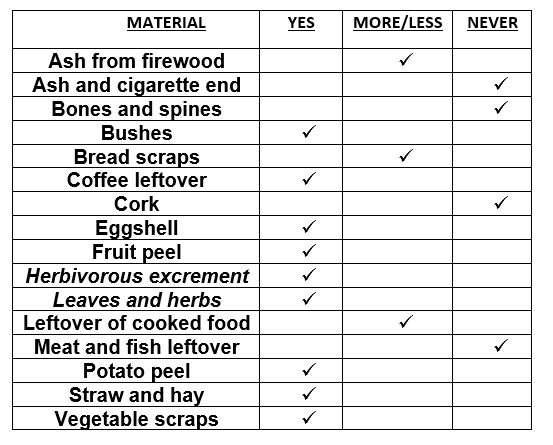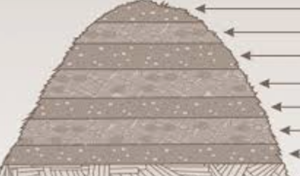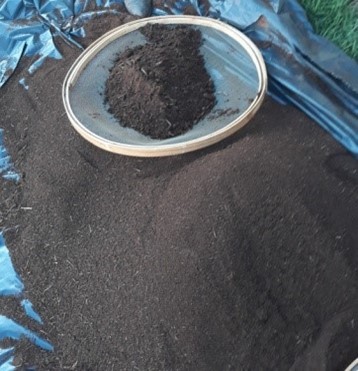The principles and guidelines for successful composting

This post is also available in:
This post is also available in:
![]() Español (Spanish)
Español (Spanish) ![]() Français (French)
Français (French) ![]() Deutsch (German)
Deutsch (German) ![]() हिन्दी (Hindi)
हिन्दी (Hindi) ![]() العربية (Arabic)
العربية (Arabic) ![]() Türkçe (Turkish)
Türkçe (Turkish) ![]() 简体中文 (Chinese (Simplified))
简体中文 (Chinese (Simplified)) ![]() Ελληνικά (Greek)
Ελληνικά (Greek) ![]() Português (Portuguese (Brazil))
Português (Portuguese (Brazil))
Composting, as a scientifically proven and technologically appropriate sustainable socio-environmental technology, consists of creating conditions, and It is recommended this favorable C/N ratio around 30/01.
Therefore, the greater the diversity of natural materials for the preparation of the compost, the better the quality of the final product in nutritional terms, in its physical and chemical aspects. However, when this in-natural raw material is not treated appropriately and the composting process does not follow some standard “rules” then the process is not successfully completed.
Problems during composting arise due to carelessness in handling. Leaving the raw material exposed to uncontrolled weather conditions can lead to its insufficient decomposition or semi-decomposition. In this case, it can cause the irrecoverable loss of its fertile elements, through the solubilization and leaching of soluble nutrients.
Furthermore, with inadequate handling, this semi-decomposed raw material can also cause serious environmental impacts, such as:
1) Contamination of surface waters and groundwater, through the transport of mineral and organic particles from the host soil;
2) Favoring the populations of harmful insects and rodents development, in addition to undesirable microorganisms, which will consume the available nutrients in the organic matter. This will reduce the nutrient reserves for plants and so it will weaken.
This can be one of the causes of the increase in the number of rodents and harmful insects in the composting areas, and also, as the expansion of diseases, such as coffee wilt disease, cassava mosaic, diseases in banana trees, vegetables, tomato plants, and others.
Therefore, the resulting organic compost produced with the correct composting process has the advantage of being a cheap natural (almost zero cost) ecologically proper, and very easily obtained fertilizer. These observations (rodents, insects, and diseases) and also the difficulties of obtaining them contradict the main objectives of composting, which are:
1) Replace chemical fertilizers, with economic, social, and environmental advantages;
2) Reduce the amount of waste produced in agricultural production;
3) Reduce environmental pollution.
The required conditions in the implementation of the proper composting.

Participatory Training in Mozambique
The chosen place for composting must:
1- Be easily accessible;
2- Be close to where the animal and plant materials that will be used as basic components, are stored;
3- Be close to a source of water. This is needed because the materials need to be wet, as the compost pile grows in successive layers of plant material and animal manure, and also when the whole pile is turned over completely, which will occur periodically every two days;
4- Be in a place with a low slope (up to 5%), to facilitate the preparation and handling of the compost pile (periodic turning over), while allowing the natural drainage of rainwater.
-Attention: Lower areas susceptible to waterlogging should be avoided.
The compost can be made in the open ground and on a dirty floor, so paved floor is unnecessary. A good place could be under the shadow of a large tree.
Places with intense and constant winds are not recommended;
Suitable material for the composting process
1) All vegetable remains from crops, gardens, and orchards (including fallen flowers and discarded fruits);
Grass clippings and small green bushes;
Leaves from resident and/or native plants are preferred.
2) Manure from animals in general, except from dogs and cats;
(Preferably manure from cattle, goats, rabbits and possible from chickens, horses, and pigs);
Ash from a firewood stove, fruit and vegetable peels and eggshells.
Important: Materials that should not be used for compost production:
1) Manure from dogs, puppies, and/or cats;
2) Eucalyptus. Eucalyptus is the only vegetable that is strictly prohibited from being added to the compost, including its leaves. Therefore, do not use eucalyptus derivatives (leaves, bushes, bark, chips, roots, sawdust, and wood shavings), under any circumstances;
(Note: Eucalyptus releases a wide variety of primary and secondary metabolites into the environment from leaves, roots, and plant remain (decomposed or not), which are capable of directly interfering with the growth of other plants and even agricultural crops. This natural phenomenon is called Allelopathy).
3) Whole stalks, thick bushes, bulky tree bark, shavings, sawdust, and wood shavings treated with pesticides in general or varnished/painted/oiled;
4) Organic matter such as skins, leathers, meats, and bones;
5) Leftovers of cooked/fried/baked food.
–Remember to remove glass, stones, metals, batteries, and plastics.
It is known that the presence of invasive plant seeds, pests, and pathogens that adversely interfere with agricultural production is also considered undesirable agents. However, pathogens and invasive plant seeds can be eliminated through the complete composting process, when conducted correctly.
Recommendations for the compost pile composition
 The assembly of the piles must obey the following sequence:
The assembly of the piles must obey the following sequence:

Pile in layers (Vegetable remains-Animal manure).
1- Distribute the first layer of plant material on the ground, approximately 20 centimeters high and 1.80 to 2.00 meters wide. The length of the windrow may vary according to the amount of materials available to be composted.
Wet evenly, before placing the next layer, which must be animal manure;
2- Over this first layer of plant material, distribute a layer of animal manure, approximately 10 centimeters high;
3- Repeat the two previous operations to obtain a pile of successive layers of vegetables and manure, approximately 1.20 to 1.50 meters high, but which can be adjusted according to convenience and easy handling;
4- Cover the finished pile with dry straw or plastic canvas to protect it from the weather and retain the composting moisture and temperature to the desirable levels.
Note: If there is firewood stove ash, it can be sprinkled manually between each double layer (vegetable/manure).
If there are discarded fruits, they must be chopped and spread on the vegetable layers. Removing the large pits (from mango, avocado, etc), is necessary.
Every two days, turn over the whole pile completely and always moisten it (without soaking) after each revolving. Throw the water on top of the pile and then cover it.

Composting pile handling
Composting time
The time needed for the transformation of raw material into organic matter depends on several factors, but mainly on humidity and temperature. The greater the control of temperature and moisture conditions, the faster the decomposition process will be by digestors, aerobic microorganisms.
It is known that the compost should be stabilized within 30 to 60 days and ripened within 90 to 120 days. After this period it will be ready for use.
It is noticed that the compost is ready to be used when it is loose and has an earthy smell. When rubbing the compost between your hands, they don’t get dirty like they would if the compost was still in the form of a sticky paste.
Moisture
One of the ways to check the moisture content is to squeeze a handful of the compost with your hands: If it has an adequate concentration of water, we will be able to feel the moisture and the aggregation of the material, which will form a “scone”, without the water slip through your fingers.
The initial moisture should be between 55 and 60%, with a minimum of 40%;
Optimal moisture: 55%;
Moisture greater than 60%: you should turn over the pile;
Moisture less than 40%: irrigate the pile.
Temperature
Temperature and transformations.
The temperature is desirable to vary from 60C° to 70C° in the first 25 days of composting. Then naturally the temperature will decrease until room temperature levels.
Temperature and moisture can be assessed with a construction iron bar inserted into the middle of the pile, from top to bottom.
The bar must be withdrawn from the pile, after a few minutes (from two to three). While removed and touched observe if
1- It’s hot and wet. In this case, there’s no need to wet the compost pile until the next turning over;
2- If it is dry, it will probably be cold too and then the pile must be wetted again until the water is at the base of the pile. Be careful not to drain it abundantly.
(Always remember: Too much water is just as harmful as too little).
Sieving
 From the moment the pile is considered “composted” and therefore ready to be used, the entire pile must be sieved as shown in the photo aside. The resulting material from the sieving is now called “Composting or Compost” and it is ready to be used as organic fertilizer of excellent quality, harmless to humans, animals, and the environment.
From the moment the pile is considered “composted” and therefore ready to be used, the entire pile must be sieved as shown in the photo aside. The resulting material from the sieving is now called “Composting or Compost” and it is ready to be used as organic fertilizer of excellent quality, harmless to humans, animals, and the environment.
That is Composting:
Economically Workable. Ecologically Proper. Socially Fair. Culturally Appropriate. Technologically Suitable and Scientifically Proven.
The next sustainable socio-environmental technology to be presented will be in liquid form, also very rich in natural and mineral nutrients from organic raw materials, in addition to having defensive properties.
It is named as BIOFERTILIZER (BIOPESTICIDE).








































































